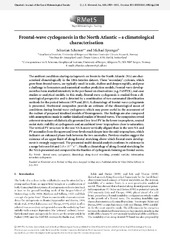| dc.contributor.author | Schemm, Sebastian | |
| dc.contributor.author | Sprenger, Michael | |
| dc.date.accessioned | 2016-03-14T14:07:33Z | |
| dc.date.available | 2016-03-14T14:07:33Z | |
| dc.date.issued | 2015-10 | |
| dc.Published | Quarterly Journal of the Royal Meteorological Society 2015, 141(693):2989-3005 | eng |
| dc.identifier.issn | 1477-870X | en_US |
| dc.identifier.uri | https://hdl.handle.net/1956/11634 | |
| dc.description.abstract | The ambient conditions during cyclogenesis on fronts in the North Atlantic (NA) are characterised climatologically in the ERA-Interim dataset. These ‘secondary’ cyclones, which grow from frontal waves, are typically small in scale, shallow and deepen rapidly, and pose a challenge to forecasters and numerical weather prediction models. Frontal-wave development has been studied intensively in the past based on observations (e.g. FASTEX), real-case studies or analytical models. In this study, frontal-wave cyclogenesis is studied from a climatological perspective and is detected by a combination of two automated identification methods for the period between 1979 and 2014. A climatology of frontal-wave cyclogenesis is presented. Horizontal composites provide an estimate of the climatological mean of conditions during frontal-wave cyclogenesis which may prove useful in the assessment of the realism of proposed idealized models of frontogenesis. The findings are also compared with assumptions made in earlier idealized studies of frontal waves. The composites reveal coherent structures of diabatically generated low-level PV in the lower troposphere, neutral moist static stability at cyclogenesis and an ambient lower troposphere close to saturation. The vertical PV structure in the east NA is more vertically aligned than in the west NA and PV anomalies from the upper and lower levels reach deeper into the mid-troposphere, which indicates an enhanced phase-lock between the two anomalies. Previous studies suggest the existence of an upper limit of along-frontal stretching above which frontal-wave development is strongly suppressed. The presented multi-decadal analysis confirms its existence in a range between 0.6 and 0.8 × 10−5 s−1. Finally a climatology of along-frontal stretching for the NA is presented and compared to the fraction of cyclogenesis forming on frontal waves. | en_US |
| dc.language.iso | eng | eng |
| dc.publisher | Wiley | en_US |
| dc.rights | Attribution CC BY-NC | eng |
| dc.rights.uri | http://creativecommons.org/licenses/by-nc/4.0/ | eng |
| dc.subject | frontal wave | eng |
| dc.subject | cyclogenesis | eng |
| dc.subject | Climatology | eng |
| dc.subject | along-frontal stretching | eng |
| dc.subject | potential vorticity | eng |
| dc.subject | deformation | eng |
| dc.subject | secondary cyclogenesis | eng |
| dc.title | Frontal-wave cyclogenesis in the North Atlantic –a climatological characterisation | en_US |
| dc.type | Peer reviewed | |
| dc.type | Journal article | |
| dc.date.updated | 2015-12-16T15:44:50Z | |
| dc.description.version | publishedVersion | en_US |
| dc.rights.holder | Copyright 2015 The Authors | en_US |
| dc.identifier.doi | https://doi.org/10.1002/qj.2584 | |
| dc.identifier.cristin | 1301649 | |

